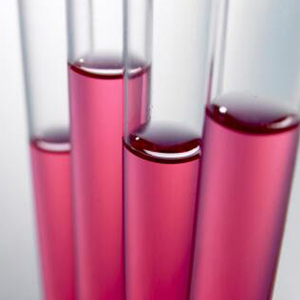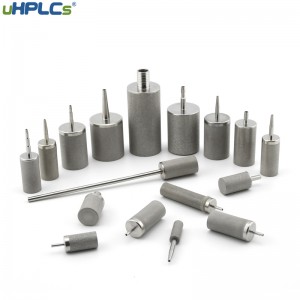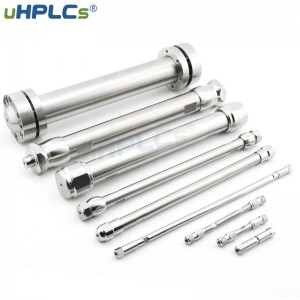An HPLC chromatography instrument can be a group of individual modules or components, but it can also be designed as a single unit. The module concept is more flexible in the event of individual component failure; the individual system parts do not have to come from the same manufacturer. You will prefer a compact instrument if you do not like to perform minor repairs yourself. However, this does not require any less bench space than a modular kit.
An HPLC chromatography instrument can be a group of individual modules or components, but it can also be designed as a single unit. The module concept is more flexible in the event of individual component failure; the individual system parts do not have to come from the same manufacturer. You will prefer a compact instrument if you do not like to perform minor repairs yourself. However, this does not require any less bench space than a modular kit.
An HPLC instrument has at least a solvent tank, transfer line with screen, high-pressure pump, injection device, column, and detector components.
I. High-Performance Liquid Chromatography
HPLC instruments typically consist of nine essential components: mobile phase/solvent container, solvent delivery system, sample introduction device, column, post-column device, detector, data collection and output system, post-detector eluent handling, and connecting tubing and fittings. Using more than one solvent is expected, so mixers and controllers are required. If a computer acquires data, it can also be used to control the entire system.
II. Solvent tank
Storage of sufficient HPLC solvent to meet the uninterrupted operation of the system and delivered to the pump by Teflon tubing through in-line degassing and filters. Typically, there are at least two reservoirs, usually glass jars, in a system. The reservoirs and their accessories will be made of glass, Teflon or stainless steel so that the mobile phase is not contaminated. We use HPLC grade methanol, acetonitrile, water and buffer as mobile phases. The mobile phase should preferably be freshly blended; contamination may occur if left for 4-5 hours, so it is recommended that the mobile phase be filtered using an HPLC solvent filter to filter out contaminants before entering the system.
III. Pumps
HPLC pumps can draw solvent at different flow rates using single or multiple vessels at the pulseless output to allow controlled mixing of different solvents/mobile phases from multiple vessels. Reciprocating pumps, syringe pumps and pneumatic pumps are types of HPLC pumps. The function of the pump is to force the liquid (called the mobile phase) through the liquid chromatography at a specific flow rate, expressed in millilitres per minute (mL/min).
The average flow rate in HPLC is in the range of 1-2 mL/min. During a chromatography experiment, the pump can deliver a constant mobile phase composition (isocratic) or an increasing mobile phase composition (gradient).
IV. Mixing unit
Mixing units are used to mix different ratios of solvents and pass them through the chromatography column.
There are two types of mixing units: low-pressure mixing chambers, which use helium to degas the solvent, and high-pressure mixing chambers, which do not require helium to degas the solvent.
Solvents are mixed using a static mixer equipped with beads or a dynamic mixer that uses a magnetic stirrer and operates at high pressure.
V. Solvent degassing
Several gases are soluble in organic solvents. Bubbles are formed when the solvent is pumped under high pressure, which can interfere with the separation process, stable baseline and peak shape. Therefore degassing is required; this can be accomplished using the following techniques.
Vacuum filtration: bubbles can be removed, but not always reliably and completely.
Helium purging: passing helium through the solvent; this is very effective but expensive.
Ultrasound uses an ultrasound instrument that converts ultra-high frequencies into mechanical vibrations, and this results in the removal of air bubbles.
VI. Chromatographic Column
The chromatographic column is the heart of the HPLC system, and it will separate the molecules in the sample mixture. The column is located behind the injector, and the mobile phase is in contact with the stationary phase, forming an interface with a vast surface. Most chromatographic developments in recent years have led to the design of many different methods to increase this interfacial contact. Typically HPLC columns are 30 to 250 mm in length, 01 to 05 mm in diameter, with pore sizes of 03, 05 and 10 microns. Chromatography columns are filled with porous particles made of polymers with a thin layer of silica and polystyrene (e.g. C8, C18 columns). Henspectrum ODS-AQ reversed-phase silica columns are C18 columns with bonding distance optimization technology, which strictly controls the distance between the long chains of bonded C18 on the silica surface and increases the contact surface between the stationary phase and the mobile phase, especially water, thus improving the retention of polar compounds.
Tube structure material.
Stainless steel (the most popular, high-pressure capability), the empty column tube assembly of HSPS is made of medical sanitary stainless steel, which can resist high pressure and is not easily damaged.
Glass (mainly used for biomolecules)
PEEK (polyether ether ketone) polymer (biocompatible and chemically inert to most solvents)
VII. Detector
The detector detects the sample eluting from the column and the column effluent. The detector converts the data into an electrical signal and is recorded by the system. The most common detector, UV/VIS, is used for drug analysis and allows continuous monitoring of UV absorption at a specific wavelength or range of wavelengths (using a PDA detector). The presence of components in the detector flow cell can cause changes in absorbance.
The main applications of HPLC are qualitative analysis, checking compounds for impurities, quantitative analysis, drug separation and identification of mixtures of components, biopharmaceutical and pharmacokinetic studies, stability studies, purification, etc.
Post time: Jul-28-2022









